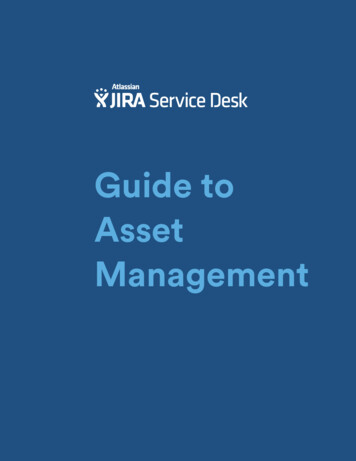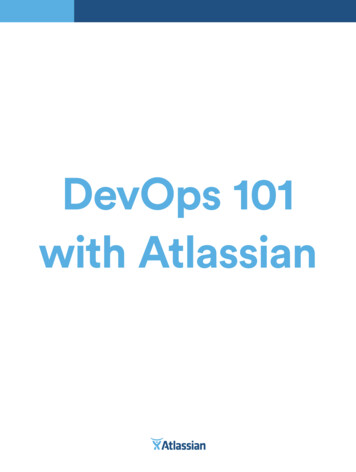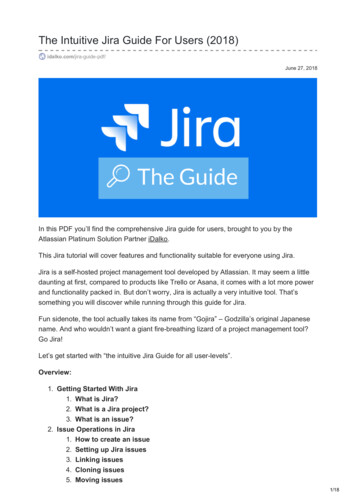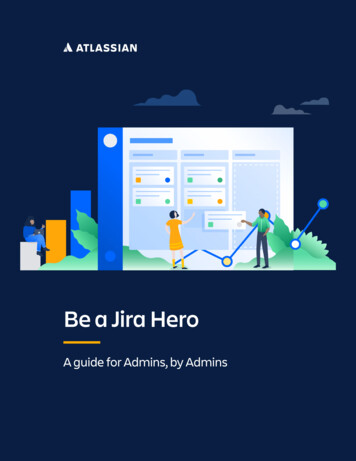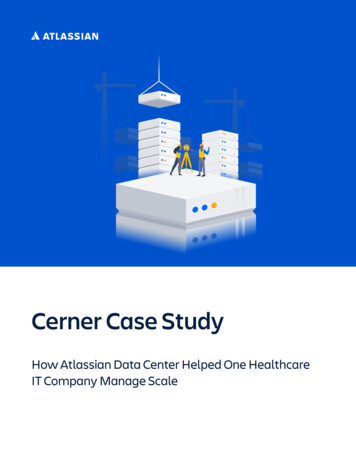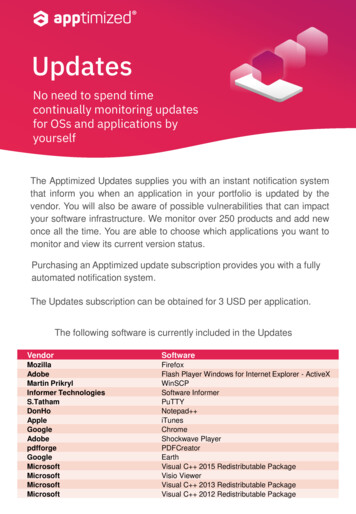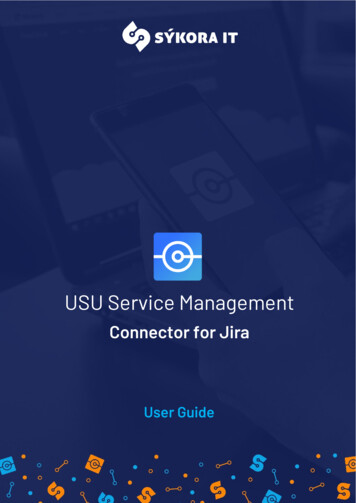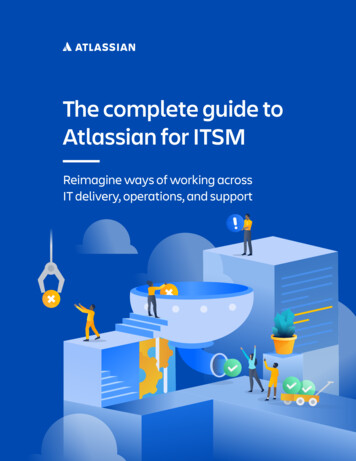
Transcription
The complete guide toAtlassian for ITSMReimagine ways of working acrossIT delivery, operations, and support
Contents4Introduction5About Atlassian8Atlassian’s approach to ITSM11Getting started with Atlassian’s ITSM solution13Service delivery14IT business management23Change enablement37Service configuration management42Knowledge management46Service operations47Incident management59Problem management64Service support65Service request management74Asset management83Enterprise service management87Resources88Atlassian Team Playbook and IT guides89Marketplace apps for ITSM91Enterprise services92Cheat sheet for collaborative ITSM95About the authorsTHE COMPLETE GUIDE TO ATLASSIAN FOR ITSM2
01Introduction
IntroductionWe live in amazing times. The world is moving at breakneckspeed, from super quantum computing to artificial intelligenceto self-driving cars. Enterprises across every industry — fromtraditional banks to pizza delivery — are undergoing massivedigital transformation powered by software. At the same time,customers have higher expectations for on-demand servicesthan ever before. When the risk of downtime means billionsin lost revenue and customer backlash, the stakes of missingcustomer expectations for availability and performance arehigher than ever. What’s more, the rise of the knowledge workerin enterprises demands instant access to informationand ways to be productive.There’s so much at stake, and it’s not slowing down anytime soon. Yet traditionalIT approaches stand in the way of change. Bounded by complex processesand expensive modules, legacy tools are inflexible and hard to adapt in the face ofincreasingly dynamic business and technology needs. Siloed systems impose frictionand constrain knowledge sharing across teams and modern tools. The growth of modernmethodologies like DevOps is putting additional pressure on IT teams to accelerateworkflows and reconsider their cultural practices.As the rise of software-powered services accelerates, IT leaders face a uniqueopportunity to help their organizations navigate this transformation. You stand at thecenter of this modernization that’s happening across the entire business, from buildingapplications and software to supporting and maintaining it, to creating seamlessprocesses for internal business teams. The time is now to evolve traditional approachesand lead your teams in navigating transformation and adopt modern ways of working.In this guide, we’re excited to share how Atlassian can support you and your teamson your journey as changemakers. Based on our experience working with leadingenterprises, we’ll share best practices on how to reimagine your core ITSM practicesby combining team-centric practices with Atlassian’s best-of-breed ITSM solution.THE COMPLETE GUIDE TO ATLASSIAN FOR ITSM4
INTRODUCTIONAbout AtlassianAt Atlassian, we know teams, and what makes them work better, together. We providethe technology backbone with the most critical collaborative workflows — agile projectplanning, incident management, and response, and service management and support —to help modern IT organizations collaboratively plan, manage and operate, serviceand support.Our solution helps teams:· Deliver transformational technologies with proven agile workflows· Manage and operate always-on services with unified incident response· Delight customers with simply powerful service management and support· Foster a culture of collaboration and trust across all teamsTHE COMPLETE GUIDE TO ATLASSIAN FOR ITSM5
INTRODUCTIONJira Service Desk has everything your ITOpsgenie is a modern incident managementteams need for service request, incident,solution that aggregates alerts and utilizesproblem, and change management out-on-call schedules, routing rules, andof-the-box, and is PinkVERIFY certified.escalation policies to notify the right peopleCustomers can submit requests via aat the right time. Opsgenie integrates withsimple self-service portal, and machineover 200 powerful apps and web services,learning will intelligently recommendso you can sync data and streamline yourthe right service and learns from everyworkflow. When integrated with Jira Serviceinteraction, so the answers are easy toDesk, support teams now have the contextfind. Agents can easily setup automationsand ability to manage incidents end-to-end,so they can focus on solving the important from reporting the incident, to escalatingstuff and help lighten the workload. Andit to the right service team, all the wayif your software teams already use Jirathrough to pushing corrective changes.Software, you can link IT tickets to thedev team’s backlog to get to the rootcause of problems before they escalate.Jira Software is the #1 softwareStatuspage lets IT teams report on thedevelopment tool used by agile teamsreal-time status of all IT services, giving the— with customizable requirement types,whole company one dedicated dashboardworkflows, permissions, and notifications.for customers and employees to check onIt provides virtual scrum and kanbanstatus information and subscribe to relevantboards for teams to collaborativelynotifications. With Statuspage, IT managersand visually manage backlogs, trackreduce the volume of inbound supportthe progress of work, and use real-timetickets while internal stakeholders getreports. IT teams can use Jira Softwarethe information they need pushed directlyto organize large change managementvia SMS and email. Statuspage takes theprojects and problem managementhassle out of incident communicationinitiatives, or with even routineand is trusted by IT teams within topmaintenance tasks. This is especiallyFortune 500 companies.helpful for teams who organize theirwork in sprints or want to visualizetheir tasks to be done with scrum andkanban boards.THE COMPLETE GUIDE TO ATLASSIAN FOR ITSM6
INTRODUCTIONthese teams to get out of email andConfluence is a collaborative workspacethat changes how modern teamswork. Teams can create anything fromcommunicate where the work is gettingdone. Everyone knows the status of tasksas cards move across lists to Done.meeting notes to project plans andproduct requirements. Create a spaceJira Align connects business andfor every team, department, or majortechnology teams to align strategy andproject to share knowledge and organizebusiness requirements with technicalwork. Use a structured hierarchy andexecution at enterprise scale. Mission,a powerful search engine to find workVision, Values, Strategies & OKRs arequickly and easily, and leave feedbackconnected to the actual work being done.with commenting. For ITSM, ConfluenceAs ideas and large bundles of work enter,is the place where service teams creatework remains linked to a correspondingcustomer-facing FAQs, internal runbooks,strategy to support full alignmentand troubleshooting guides.between the business, technology, andproduct management organizations.Bitbucket is the Git solution for professionalteams. Bitbucket makes it easy for teamsto collaborate using pull requests, inlineFurthermore, work delivered is measuredagainst outcomes to inform ongoingprioritization and decision-making.comments, diff views, and powerfulintegrations. Bitbucket scales as your teamThe Atlassian Marketplace empowersgrows, with an active-active clusteringteams to customize Atlassian productsoption for self-managed deployment, andwith thousands of different apps anda powerful SaaS offering. Most importantly,integrations. Tailor your tools to suit theit works well with the tools you already useway your teams work with apps thatto help your teams build better softwareoffer additional functionality andwith CI/CD, apps, APIs, and the best Jiraintegrations that allow you to plugintegration on the market.into your existing tools to gain greaterTrelloend to end visibility. Extend your ITSMsolution with best-of-breed apps acrossTrello improves cross-team collaborationcategories such as asset managementand breaks down barriers, offering aand CMDB, automation, advancedvisual way for business and IT teams toreporting, and more.collaborate on any project. Trello providesinformation at a glance where teamscan see the big picture, or dive into thedetails, all on one Trello board. It enablesTHE COMPLETE GUIDE TO ATLASSIAN FOR ITSM7
INTRODUCTIONAtlassian’s approach to ITSMAtlassian’s mission is to help unleash the potential of every team. We believe that behindevery great human achievement, there is a team. But great teamwork requires more thanjust the tools and products used by the team. It also involves the culture and practicesteams follow to get work done.That’s why our approach to ITSM begins with teams at the center and combinesstrong culture, proven practices, and collaborative tools to help IT teams achieve theirfull potential.Building a strong culture with the Atlassian Team PlaybookChanging your organization’s culture can be daunting, and it usually doesn’t happenovernight. But through small, incremental steps, impacting the culture on your team ispossible. Start with developing a set of “plays” for working through common problems.Based on years of research and experimenting with an open way of working in ourorganization, we created the Atlassian Team Playbook. These step-by-step techniquesand exercises remove the naturally-occurring friction teams face, such as assessingyour team’s health, learning through retrospectives, making high-impact decisions, andmore. We even developed IT-specific plays to help service and incident response teamsbecome more agile.THE COMPLETE GUIDE TO ATLASSIAN FOR ITSM8
INTRODUCTIONDeveloping proven practices inspired by ITIL 4When it comes to practices, ITIL 4, the latest update of the widely usedIT Infrastructure Library (ITIL) framework, is a valuable guide. While ITIL has led the ITSMindustry with guidance and training for over 30 years, the newest version brings ITIL intothe broader context of customer experience, value streams, and digital transformation,as well as embraces modern ways of working, such as agile and DevOps.One significant change is shifting the interpretation of overly-prescriptive “processes”to more flexible and holistic “practices.” ITIL 4 puts service management practices intoa strategic context by incorporating service management, development, operations,business relationships, governance, and even culture. For organizations using ITIL 4as a reference, Atlassian’s ITSM solution enables organizations to adopt new, modernpractices that fit their needs and deliver higher value to the business.A collaborative solution with Jira Service Desk at the heartFrom the start, Atlassian’s ITSM solution was designed to address traditional ITresponsibilities with modern practices in mind, such as culture, collaboration, andimproving the flow of work. Built and extended from Jira, the engine for agile workpractices for thousands of customers, it favors semi-autonomous, accountable teamsthat are empowered to deliver an impact on the business. It emphasizes collaborationand openness, so teams learn from collective insights and manage with greater visibilityacross the organization.THE COMPLETE GUIDE TO ATLASSIAN FOR ITSM9
INTRODUCTIONAtlassian unites IT on one platform: Bringing delivery, operations and support toone collaborative experience.· With Jira Service Desk at the core, IT teams, across infrastructure, operations, andworkplace support, enjoy a team-centric IT support workspace that matches theway they work with flexible ITIL workflows, a self-service portal, agent queues,automation, SLAs, custom dashboards, and much more.· Strong integration with Jira Software brings development and IT teamstogether using a common platform to speed service requests through to changesand releases.· Confluence provides the backbone for knowledge management, providingreal-time collaboration and access to support articles, troubleshooting guides,runbooks, and more.· The integration with Opsgenie and Statuspage offers a seamless end-to-endincident management solution.· Outside of IT, the adoption of Jira Service Desk spreads quickly to business teams,such as HR, Facilities, and Legal, who recognize the value of easily managing andtracking their flow of work.· Finally, further customize and extend your solution with best-of-breed apps, suchas asset management and advanced analytics, from the Atlassian Marketplace.Discover the business impact of Jira Service DeskAccording to Forrester Consulting’s Total Economic Impact report on Atlassianfor ITSM, companies gain considerable value from adopting Jira Service Desk:246%ROI61%improvement inagent productivity819K in savings from retiringlegacy ITSM toolsLearn moreTHE COMPLETE GUIDE TO ATLASSIAN FOR ITSM10
INTRODUCTIONGetting started with Atlassian’s ITSM solutionSetting a solid foundation before embarking on any journey is critical for success.We recommend these best practices as you get started with Atlassian:1. Embrace a team-centric approach to ITSMAt Atlassian, we believe that open teams work better together. Many IT teamsbelieve they’re using the “right” tools and following the “right” processes,but still fail to achieve results. In fact, these tools and processes can actuallycreate inefficiencies, for example, between IT and Dev team due to silos andlack of knowledge sharing. We found at Atlassian that establishing a culturearound collaboration and transparency is the foundation to a successful ITSMimplementation. By using the Atlassian suite, you’re already one step closer toleading your organization toward open knowledge sharing. Open and collaborativeculture is infused in the Atlassian toolset. For example, Confluence pages haveopen permissions by default, which enables team members to easily access andcollaborate in real-time.2. Step back, and start where you areAs you define your organization’s culture and practices, ITIL 4’s Guiding Principlesare a great place to begin. (In fact, we found them to be quite similar to theAgile Manifesto!) One of these principles is, “Start where you are.” With 34 ITIL 4management practices to consider, it can feel overwhelming. Instead of buildingfrom scratch, take a moment to observe and analyze the services, methodologies,people, and tools you already have. Then use these insights to identify where to startand what to continue, change, or build upon.3.Take a top-down approach starting with the service layerWhen beginning an ITSM deployment, the idea of fully defining your service modeldown to the infrastructure can be paralyzing. Instead of diving into infrastructureand microservices out of the gate, focus on the top services most critical to yourbusiness (such as an e-commerce platform if you’re a retailer). To identify theseservices, review tickets from the past few months to understand which services aremost utilized.THE COMPLETE GUIDE TO ATLASSIAN FOR ITSM11
INTRODUCTION4. Achieve quick wins with a minimal viable productFor many organizations, getting employees to embrace change can be difficult.Maximize your chances for success by taking an agile approach to deployingyour ITSM solution. Instead of rolling a full-blown solution at once, identify yourorganization’s biggest pain points, and focus on the practice, service, or use casethat will be most impactful. By starting with a minimal viable product (MVP) anditerating on the solution over time, you’ll help your organization overcome the fearof change while satisfying a significant portion of your stakeholders.5. Match your software stack to your maturity and needsAccording to Gartner, Infrastructure & Operations (I&O) leaders overpay by 600million on buying unused features of ITSM tools. Instead of committing upfront toa costly ITSM platform with complex features you’ll never use, take an adaptiveapproach to build your solution. The needs of your business are constantly changing— so buy only what you need. Atlassian’s ITSM solution offers out-of-the-box ITILpractices with the flexibility to scale as you grow. And, our broad ecosystem ofMarketplace apps allows you to customize and extend your capabilities, withoutthe need for specialized consultants.6. Scale your solution and celebrate successAs you continue on your journey, communication is critical to increasing adoption.Once a service or practice is up and running, shout it from the rooftops. Offerhands-on training, pass out stickers, and incentivize usage through contests. As JiraService Desk gains adoption, business teams, from HR to Legal, will begin to realizethe value and request service desks of their own. To manage and scale this growth,treat each request as an endeavor of shared objectives. Seek first to understandthe problem each team is facing, and solve it in a consultative manner. Finally,don’t forget to celebrate each milestone with your team!THE COMPLETE GUIDE TO ATLASSIAN FOR ITSM12
02Service delivery
Service deliveryIT business managementWith the rise of digital transformation comes many innovative ideas from the businessside of the organization. IT teams are at the center of this transformation, supportingthe demand for new services or application changes. However, this influx of requestsoften results in unhealthy demand management. As business stakeholders ideate andscope new ideas, they often involve the IT organization too late, missing opportunitiesfor collaboration and leaving IT teams to play catch up. While the business tends to askfor twice the capacity available, IT can only deliver half of the project due to resourceconstraints determined way before the project started. As the pace of innovationaccelerates and business teams move even faster, IT faces an ever-growing backlog andtechnical debt.What is IT business management?IT business management is the discipline of delivering business value from ITworkflows and tools. The goal is to create value for customers through technologyby addressing business goals, strategies, and needs.According to ITIL 4“Successful project management is important as the organization must balanceits need to:··Maintain current business operations effectively and efficiently·Continually improve its products and service”Transform those business operations to change, survive, and compete inthe market placeITIL Foundation: ITIL 4 Edition, 5.1.8, Project managementTHE COMPLETE GUIDE TO ATLASSIAN FOR ITSM14
SERVICE DELIVERYAs software development begins to play a more prominent role in every company,techniques such as lean, agile, and DevOps are spilling beyond their software originsinto the domain of IT project management. Not only do these methods bring modernpractices, tools, and jargon, they also introduce crucial questions such as:· How does the Project Management Office (PMO) strike a balance between incomingbusiness demand and IT’s capacity to deliver?· How do you tackle big, audacious projects while empowering teams to executethem iteratively and incrementally?· How do software and IT projects fit into the broader context of businessplanning? Do the right teams have a “seat at the table”?We find that organizations are living with traditional management assumptions that nolonger apply. As IT organizations reconsider how to source, prioritize, and flow work toteams, Atlassian offers tools to enable business and IT teams to better communicate,collaborate, and manage project and IT work intake.· With Jira Service Desk, IT teams can easily capture business requests for newtechnology, enhancements, and bug reports. Our tools also use visual boards to seethe flow of work and bottlenecks.· Jira Software is used by IT and software teams to manage project work viakanban boards, while business teams use Trello’s simple drag-and-drop cards tocommunicate project status with stakeholders.· Finally, the Atlassian Team Playbook offers practices inspired by agile and DevOpsto help IT teams gain a “seat at the table.”IT business management checklistEasily capture strategic business requests with self-serviceAdopt practices to open col
92 Cheat sheet for collaborative ITSM 95 About the authors Contents. 01 Introduction. THE COMPLETE GUIDE TO ATLASSIAN FOR ITSM 4 Introduction We live in amazing times. The world is moving at breakneck speed, from super quantum computing to artificial intelligence to se

